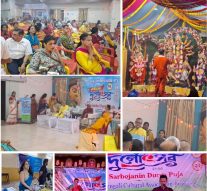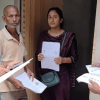Goa is abuzz with excitement as vintage bike and car owners, users, collectors and fans are decking […]

DURGA PUJA OFFERINGS FOR THE FESTIVE SEASON…
Eating is Fun / Eating is Yuck! - A variety food column October 4, 2025SOME food for thought this time around on the subject of two celebrations revolving around two goddess avatar – as the goddess Amba in Navaratri and the goddess Durga in Durga Puja. This year I really noticed the differences and similarities between both the celebrations… …over the years I’ve seen how the they have grown with more and more young members of the communities seeking – yes, a feeling of community fellowship!
Two states as different as chalk from cheese, Gujarat and West Bengal – but both very religiously inclined in differing ways, and you may have noticed how there is a further revival of religious fervor around the world…as if doomsday is near (as the world stands on the edge of a nuclear war and subsequent nuclear winter as it is described).
For some reason I find I tend to attend the Durga Puja being hosted privately at Bengali friends’ homes, or on a larger “sarvajanik” or community scale at a hall where a pandal is put up and here is installed the splendid image of Hinduism’s warrior goddess Durga with ceremonial rites and rituals – this year it was the Bengali Cultural Club’s 45th celebration in Goa from September 28 to October 2, it all ends on Dassera day. Well, there’re aarti morning and evening when there’s bhajan sangeet sessions, cultural performances and other interesting events, including a “bhog” meal and some of the Bengali housewives may put up stalls featuring the traditional dishes of Bengali cuisine which are much sought after by the connoisseurs of food which Bengali people are anyway. (You won’t find traditional Gujarati dishes at the Navaratri garba-ras dandiya evenings though where the community gathers for nine nights for prayers and energetic garba and ras-dandiya in evocation of Amba maa). The goddesses of Hindudom come in various avatar and 108 is the magic number generally speaking…
SINCE I was focusing on Durga Puja it looked like there were half-a-dozen private puja in Goa, including Margao, Vasco da Gama and even Calangute I’m told. Community pandals are always worth visiting and I’m sorry I missed out on visiting the Durgamata Seva Trust’s Sarvajanik Durga Puja in its 33rd year of celebration in Margao (the one near the Konkan Railway station) which was very eloquently done up I hear.
NEEDLESS to say part of the charm of going to say hello to the goddess Durga (religious folk legend says she’s home to her maike for four days with her children) is to partake of the “bhog” meal of whatever is made to welcome the goddess – the Bengali Durga Puja “kichuri” is most delicious and it there will be always be a chutney of raisins or dates and tomato or pineapple…absolutely yummylicious with tangy flavours, then may be “baingan bhaja” or eggplant fritters, “aloo dum,” “basanti pulao,” the piece de resistant sweet of “noton gur sandesh” (made of date palm jaggery).
As in most cases the bhog meals for the duration of the puja is sponsored by a philanthropist of the community. Also, in some cases there’ll be small exhibition sale of handloom sarees, good honey, home-made snacks, etc, all worth buying for the home. I always look for ivory white carved shell bangles maybe mats of hand-woven reeds, they are so cool to lie down on!
NOWADAYS of course regardless of Durga Puja or Navaratri all the events are filmed on video by both professionals and amateurs, most everybody…so you may get to see everything in an armchair at home. You’ll be surprised that many of the colorfully mirror and ribbon worked garba-raas dandiya outfits may be hired for participating in competitions put up on the schedule by community’s organizing community. Navaratri evenings are super charged and I’m sorry to say the food and beverages mostly run-of-mill popular fare … maybe jalebi-fafda along with pau-bhaji, chole-bhatura, chaat item numbers, ice-creams and sweets galore. Bottled water sells out quickly. Navaratri evenings are more expensive affairs if I may say so but then the competitions put up yield prize money for the participants.
SINCE I so many Bengali friends beginning with Mita and Kisholay Sen in Kolkotta and Mun Mun Ghosh in Mumbai and Ajanta Burman (Bengali cuisine chef extraordinary) in Panjim, I can say I have grown up taking to Bengali food like a duck, including fish Bengali- style (that is when it is cooked a la “paturi” style in banana leaves)….and of course every Durga Puja in Mumbai which was Bombay once I would go offer some floral tribute to one of the replendant Durga-maa pandal puja, appeal to the goddess for save me from perdition and wipe a few tears off my cheeks along with my friend Mita and her mother Ruby-mausi for Durga was only on a 4-day visit to her maike with her children and had to be given a send off to her sasural loaded with goodies….etcetera, one may identify and always get emotional saying goodbye to the goddess of many Bengali hearts as also non-Bengali ones! I always say I prefer the Bengali Durga Puja to any other kind of puja and not only because because it comes with the best “bhog” feast accompanying it.
Here is my friend Mita’s recipe for tomato chutney as she taught me to make it years ago using the aromatic mix of “panchporon” for the tempering in mustard oil naturally; panchporon is equal mix of sesame seeds, fenugreek seeds, aniseeds, cumin seeds and onion seeds (rai, methi, saunf, jeera and the raduni (black onion seeds, so loved in Bengal and sometimes used in dotting various leavened and flatbreads.
FINALLY, a simple recipe for Tamatar Chutney:
TAKE half kg firm tomatoes, a cup of golden raisins or dates for sweet touch, two or three slit green chillies, generous knob of julienned or chopped yellow ginger; a teaspoon or tablespoon of panchporan to temper in mustard oil or another lighter oil if you think mustard oil is too strong. One uses very little portions of mustard oil of course for it is usually cold-pressed and not refined.
TO MAKE heat sesame seed oil, add panchporan when oil is hot, then add in tomato wedges, chopped ginger, slit green chilies….stir once, twice, add in rinsed and clean golden raisins or chopped dates (or a mix of both if you wish). Add sea salt to taste. Cook till the chutney is thickish, temptingly aromatic…serve with, “kichuri” (savoury porridge consistency of rice and mixed dal), or “luchi” (fine thin puffed up maida puri of Bengali homes). Enjoyyyyy! Mita also used to make these dulcet sugar syrup laced “grated coconut” ladoo for her young boys to eat, “they’re terribly nutritious!” Or so she would say while I said, “Yuk, Mita, so bloody rich! How can even kids eat this!”
But then her table would be loaded with other pleasures of the palate like “baingan bhaja” (purple aubergine large fritters), mashed potato spiked with green chilli, sea salt, wee mustard oil…of course panchporon tomato chutney, all to go with hot ghee-laced rice (rice being a Bengali staple with any household stocking at least three varieties) or the fine Guju “phulka” which I was happy to make whenever I was visiting! Fish is the second staple, lest I forget, that’s another entire column.
This is to say I have always had some fun learning times with my Bengali friends in Kolkatta (remember Bengal is influenced by the Portuguese and British who later on made it their HQ for the British East India Company for the entire British Raj and extended empire)… I and I may not forget all the “mishti doi” (sweetened creamy tangy curd, sweetened with palm jaggery/”noton gur” or in mod con times just refined sugar), also the Bengali samosa version called “singara,” and “rossogolla,” freshly made “sandesh”…this is to say thank you Durga maa for being very much a part of my otherwise pretty mixed up life! And “Bijoya Dassera” to all my friends!















